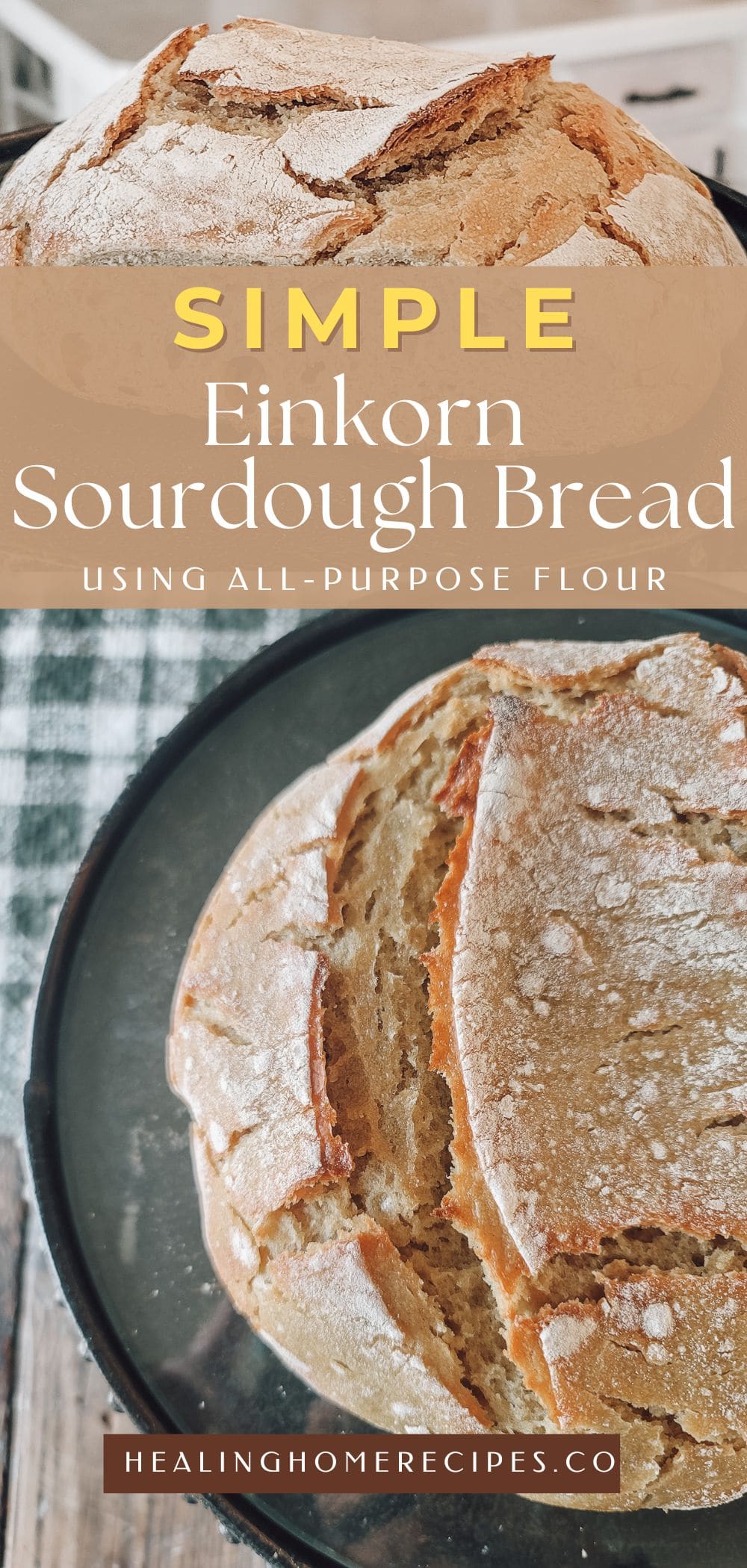There's not much you need to make bread! This simple einkorn sourdough bread recipe using all-purpose flour uses only a few ingredients and it comes out looking and tasting perfect every time. Add a dollop of buttah on top and you've got a delectable sourdough snack, breakfast, or feast.

This page may contain affiliate links. To view my full affiliate link disclosure, click here.
I love baking with whole wheat einkorn, but goodness it is not an easy flour to work with. Sometimes I feel like it's impossible flour to work with. Basically, it's hormonal. I'll bake the recipe the same exact way with the same exact starter five different times and get five different results.
For my own sanity, I needed less hormonal flour to work with. Even though whole wheat einkorn is technically the preferred einkorn with Trim Healthy Mama recipes, I decided to ditch my whole wheat for a time and experiment with all-purpose einkorn flour.
The results were incredible!
After working with whole wheat for so long, all-purpose flour was a breeze! I made the recipe multiple times and each time had the same result, which was a lovely and fluffy einkorn sourdough bread loaf.
You'll want to pin this recipe and then come back to it time and time again until it's fully memorized!
Jump to:
Ingredients
All you need for this recipe is

- Sourdough Starter
- In the recipe card, I will explain how to make a full cup of sourdough starter. However, if you have an excess fed sourdough starter in your regular kept starter you can also use that. you
- Filtered water
- The filter part is important. There is a science to sourdough bread, and part of that science is having healthy bacteria. Be careful of water that is not filtered.
- All-Purpose Einkorn Flour
- In this recipe, we are using all-purpose einkorn flour. All-purpose is easier to work with and produces a fluffier loaf of bread.
- Salt - We prefer to use Redmond Real
- salt is used to add flavor to the bread.
See the recipe card for quantities.
Instructions
It's important that you follow sourdough instructions well. For many recipes that I make, I totally use creative freedom when making and modifying the recipe based on what I have around my kitchen. In the case of sourdough, you cannot do this because it will affect the final results. You will want to follow the steps precisely.

Feeding your starter - 12 hours before you mix your bread dough, make your starter. This makes roughly 1 cup of starter. Add 1 ½ tbsp of starter to a clean jar or bowl. Add ¾ cup of all-purpose einkorn flour and ½ cup filtered water.
If you have enough starter, just feed it 12 hours before you plan on making your bread and directly take it out of your starter jar. Remember to feed it again!

Mix your dough - Add the sourdough starter, 4 ¼ cups all-purpose einkorn flour, 2 tsp salt, and 1 ¼ cup filtered water to a bowl. Use a Danish Dough whisk or a spatula to mix the ingredients together. Let rest for 1 hour.

Stretch and Fold - Flatten the dough and stretch and fold in the corners of the dough. Shape it into a ball. Cover and let rest for 20 minutes. Repeat this process an additional time.

First Rise - Cover the dough with plastic wrap and let the dough rest for 7-12 hours.

Shape the Loaf - Take the dough out of the bowl. Use a scrapper if the dough is sticky. Turn it onto a floured surface. Pull the sides of the dough into the middle as you work your way around the outside. Flip the dough over and repeat the process. Cup the dough with your hands and turn it upside dough into a proofing basket.

Second rise - Allow the dough to rest for 1 hour and 30 minutes. During the last 30 minutes, preheat the oven to 500 degrees F. Put a Dutch oven in the stove at the same time to preheat.

Score the Dough - Take the Dutch oven out of the stove. Turn the dough out onto a piece of parchment paper. The dough will be right side up. Use a lame or a razor blade to score the dough. Do not score more than ¼ inch deep. Use the parchment paper like a sling to put the dough into the Dutch oven. Put the lid on and put the Dutch oven into the stove. Reduce stove temperature to 450 degrees F.

Bake - Bake for 40 minutes with the lid on. At 40 minutes check the bread to see if you like the darkness of the crust. If you want a darker crust, bake for an additional 5-10 minutes uncovered.
Hint: Einkorn dough tends to be extra sticky to work with. If the floured surface is not enough to keep the dough off of your hands, wet them

Variations
Here are a few variations that you can try if you want a slightly different result.
- Whole Wheat - If you want to try a whole wheat recipe, the process will be slightly different, I recommend checking on this recipe on my website.
- Cheese - if you want to make cheesy sourdough you can add shredded cheese during the last "Shape your Loaf" step of the directions.
- Sandwich Bread - Einkorn sandwich bread is an excellent choice for a less dense crust. You can find my einkorn sandwich bread recipe here.

Equipment
- Glass bowls
- Proofing or banneton basket
- Measuring cups
- Measuring spoons
- Danish dough whisk
- Dutch Oven
- Plastic wrap
- Parchment paper = we prefer the kind that has not been bleached!
You can find all my kitchen essential favorites, including all my sourdough equipment in my Amazon storefront or Like to Know Shop.
Storage
It is said that because of the phytic acid that is in sourdough, it lasts on the countertop much longer than other baked bread. In our home sourdough does not last very long, I typically keep it on the counter for up to one week. You can also place your bread in a bread box, air-tight container, plastic bag, or bread bags to make it last longer.

Top tip
Understanding how Einkorn works is the best tip that I can give you. Although it's not incredibly complicated, einkorn does work differently than other sourdough flours! The slightest adjustment could make the biggest difference. Check out my complete beginner's guide to einkorn sourdough for all my tips and tricks.

FAQ
How do you turn a sourdough starter into einkorn?
You can convert your regular wheat sourdough start to an einkorn sourdough starter. Start feeding and discarding your sourdough starter with einkorn flour. By the 6-7th time, you will have almost an entire einkorn sourdough starter.
Can I use my starter instead of making it fresh?
If you have enough starter, then yes!
Feed your sourdough starter 4-12 hours in advance prior to making this recipe. It should be nice and bubbly and at least doubled in size.
Is einkorn flour safe for celiacs?
No. Einkorn is an ancient grain that has been minimally processed. However, it still contains gluten, which makes it unsafe for anyone with celiac.
How does einkorn bread taste?
It certainly is not the same as store-bought bread. I think it tastes better and purer. However, other people have found it too heavy of a tasting bread. If you have ever enjoyed rye bread, I liken it to that, except for a tamer version.
Does einkorn spike insulin?
Studies are starting to indicate that einkorn flour may work differently in the bloodstream than other flour. I have a friend with diabetes and she carefully monitors her blood sugar levels. I was ecstatic when she messaged me to let me know that she had made some of my recipes and her blood sugar had done fabulous with Einkorn. I strongly suggest you carefully consult with your physician if you have diabetes and are experimenting with einkorn flour.
Related
Looking for other recipes sourdough recipes like this? Try these:

Einkorn Sourdough Bread (with All-Purpose Flour)
Ingredients
Sourdough Starter
- 1 ½ tablespoons sourdough starter
- ¾ cup all-purpose einkorn flour
- ½ cups water
Dough
- 1 cup active sourdough starter (from above)
- 1 ¼ cup filtered water
- 4 ¼ cups all-purpose einkorn flour
- 2 tsp salt
Instructions
- Feeding your starter - 12 hours before you mix your bread dough, make your starter. This makes roughly 1 cup of starter. Add 1 ½ tbsp of starter to a clean jar or bowl. Add ¾ cup of all-purpose einkorn flour and ½ cup filtered water.
- Mix your dough - Add the sourdough starter, 4 ¼ cups all-purpose einkorn flour, 2 tsp salt, and 1 ¼ cup filtered water to a bowl. Use a Danish Dough whisk or a spatula to mix the ingredients together. Let rest for 1 hour.
- Stretch and Fold - Flatten the dough and stretch and fold in the corners of the dough. Shape it into a ball. Cover and let rest for 20 minutes. Repeat this process an additional time.
- First Rise - Cover the dough with plastic wrap and let the dough rest for 7-12 hours.
- Shape the Loaf - Take the dough out of the bowl. Use a scrapper if the dough is sticky. Turn it onto a floured surface. Pull the sides of the dough into the middle as you work your way around the outside. Flip the dough over and repeat the process. Cup the dough with your hands and turn it upside dough into a proofing basket.
- Second rise - Allow the dough to rest for 1 hour and 30 minutes. During the last 30 minutes, preheat the oven to 500 degrees F. Put a Dutch oven in the stove at the same time to preheat.
- Score the Dough - Take the Dutch oven out of the stove. Turn the dough out onto a piece of parchment paper. The dough will be right side up. Use a lame or a razor blade to score the dough. Do not score more than ¼ inch deep. Use the parchment paper like a sling to put the dough into the Dutch oven. Put the lid on and put the Dutch oven in the stove. Reduce stove temperature to 450 degrees F.
- Bake - Bake for 40 minutes with the lid on. At 40 minutes check the bread to see if you like the darkness of the crust. If you want a darker crust, bake for an additional 5-10 minutes uncovered.
Recommended Products
As an Amazon Associate and member of other affiliate programs, I earn from qualifying purchases.
Nutrition Information:
Yield: 12 Serving Size: 1Amount Per Serving: Calories: 209Total Fat: 1gSaturated Fat: 0gTrans Fat: 0gUnsaturated Fat: 1gCholesterol: 0mgSodium: 391mgCarbohydrates: 44gFiber: 6gSugar: 0gProtein: 8g
Online nutritional calculators are estimates only. Use your best judgement when consuming.
Don't forget to pin me for later!













